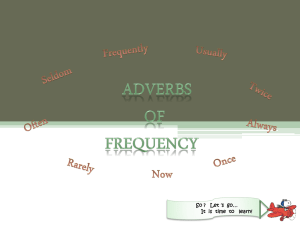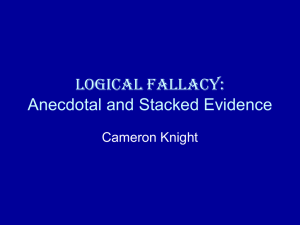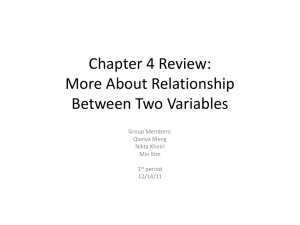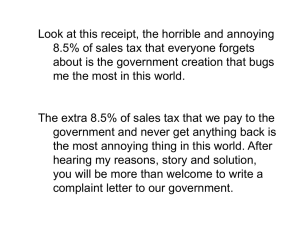Exploring their Application to Social Network Analysis
advertisement
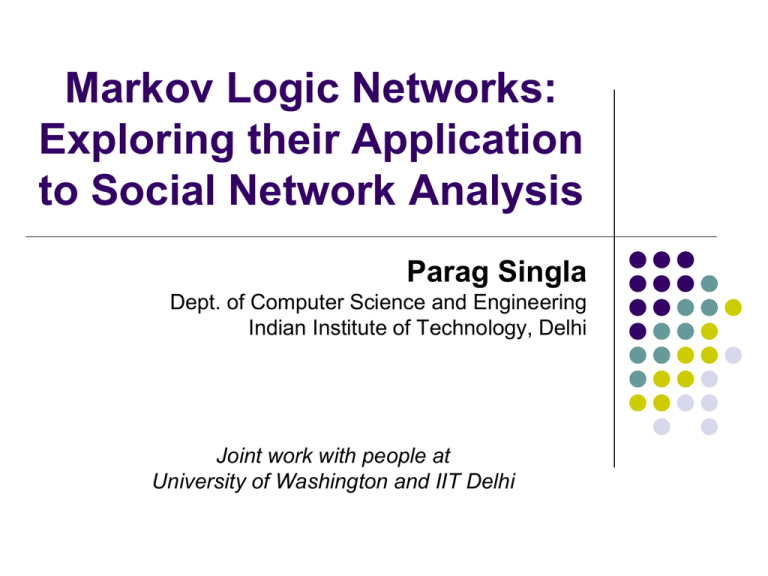
Markov Logic Networks:
Exploring their Application
to Social Network Analysis
Parag Singla
Dept. of Computer Science and Engineering
Indian Institute of Technology, Delhi
Joint work with people at
University of Washington and IIT Delhi
Overview
Motivation
Markov logic
Application to Social Network Analysis
Opportunities/Challenges
Social Network and Smoking
Behavior
Smoking
Cancer
Social Network and Smoking
Behavior
Smoking leads to Cancer
Social Network and Smoking
Behavior
Smoking leads to Cancer
Friendship
Similar Smoking
Habits
Social Network and Smoking
Behavior
Smoking leads to Cancer
Friendship leads to Similar Smoking
Habits
Examples
Web search
Information extraction
Natural language processing
Perception
Medical diagnosis
Computational biology
Social networks
Ubiquitous computing
Etc.
Examples
Web search
Information extraction
Natural language processing
Perception
Medical diagnosis
Computational biology
Ubiquitous computing
Etc.
Motivation
Real World
Entities and Relationships
Uncertain Behavior
Motivation
Real World
Entities and Relationships
Uncertain Behavior
Markov Logic
=
First Order Logic
+
Markov Networks
Overview
Motivation
Markov logic
Application to Social Network Analysis
Future Directions
Markov Logic
[Richardson and Domingos 06]
A logical KB : A set of hard constraints
How can we make them soft constraints
Give each formula a weight
(Higher weight Stronger constraint)
P(world)
exp
weights
of formulas
it satisfies
Example: Friends & Smokers
x Smokes ( x ) Cancer ( x )
x , y Friends ( x , y ) Smokes ( x ) Smokes ( y )
Example: Friends & Smokers
1 .5
x Smokes ( x ) Cancer ( x )
1 .1
x , y Friends ( x , y ) Smokes ( x ) Smokes ( y )
Example: Friends & Smokers
1 .5
x Smokes ( x ) Cancer ( x )
1 .1
x , y Friends ( x , y ) Smokes ( x ) Smokes ( y )
Two constants: Anil (A) and Bunty (B)
Example: Friends & Smokers
1 .5
x Smokes ( x ) Cancer ( x )
1 .1
x , y Friends ( x , y ) Smokes ( x ) Smokes ( y )
Two constants: Anil (A) and Bunty (B)
Smokes(A)
Cancer(A)
Smokes(B)
Cancer(B)
Example: Friends & Smokers
1 .5
x Smokes ( x ) Cancer ( x )
1 .1
x , y Friends ( x , y ) Smokes ( x ) Smokes ( y )
Two constants: Anil (A) and Bunty (B)
Friends(A,B)
Friends(A,A)
Smokes(A)
Smokes(B)
Cancer(A)
Friends(B,B)
Cancer(B)
Friends(B,A)
Example: Friends & Smokers
1 .5
x Smokes ( x ) Cancer ( x )
1 .1
x , y Friends ( x , y ) Smokes ( x ) Smokes ( y )
Two constants: Anil (A) and Bunty (B)
Friends(A,B)
Friends(A,A)
Smokes(A)
Smokes(B)
Cancer(A)
Friends(B,B)
Cancer(B)
Friends(B,A)
Example: Friends & Smokers
1 .5
x Smokes ( x ) Cancer ( x )
1 .1
x , y Friends ( x , y ) Smokes ( x ) Smokes ( y )
Two constants: Anil (A) and Bunty (B)
Friends(A,B)
Friends(A,A)
Smokes(A)
Smokes(B)
Cancer(A)
Friends(B,B)
Cancer(B)
Friends(B,A)
Example: Friends & Smokers
1 .5
x Smokes ( x ) Cancer ( x )
1 .1
x , y Friends ( x , y ) Smokes ( x ) Smokes ( y )
Two constants: Anil (A) and Bunty (B)
Friends(A,B)
Friends(A,A)
Smokes(A)
Smokes(B)
Cancer(A)
Friends(B,B)
Cancer(B)
Friends(B,A)
State of the World {0,1} Assignment to the nodes
Probability Distribution
P ( x)
exp
wi ni ( x )
Z
i MLN formulas
1
Weight of formula i
No. of true groundings of formula i in x
Computing Probabilities: Marginal
Inference
Friends(A,B)
Friends(A,A)
Smokes(A)?
Smokes(B)?
Cancer(A)
Friends(B,A)
Friends(B,B)
Cancer(B)?
What is the probability Smokes(B) = 1?
Inference: Belief Propagation
Smokes(Anil)
Variables
Smokes(Anil) Friends(Anil, Bunty)
Smokes(Bunty)
Clauses
Belief Propagation
x f ( x )
h x
h n ( x ) \{ f }
( x)
Clauses
Variables
wf
f x (x) e
~{ x }
(z)
y f
y n ( f ) \{ x }
( y)
Lifted Belief Propagation
[Singla and Domingos, 2008]
, :
Functions
of edge
counts
x f ( x )
h x
h n ( x ) \{ f }
( x)
Clauses
Variables
wf
f x (x) e
~{ x }
(z )
y f
y n ( f ) \{ x }
( y)
Learning Parameters
[Lowd and Domingos 07]
w1?
x Smokes ( x ) Cancer ( x )
w 2?
x , y Friends ( x , y ) Smokes ( x ) Smokes ( y )
Learning Parameters
[Lowd and Domingos 07]
w1?
x Smokes ( x ) Cancer ( x )
w 2?
x , y Friends ( x , y ) Smokes ( x ) Smokes ( y )
Three constants: Anil, Bunty, Priya
Smokes
Cancer
Friends
Smokes(Anil)
Cancer(Anil)
Friends(Anil, Bunty)
Smokes(Bunty)
Cancer(Bunty)
Friends(Bunty, Anil)
Friends(Anil, Priya)
Friends(Priya, Anil)
Closed World Assumption:
Anything not in the database is assumed false.
Overview
Motivation
Markov logic
Application to Social Network Analysis
Observations/Challenges
Large Social Network Analysis
Twitter Datasets
[Ruhela et al. ANTS 2011]
SNAP Twitter7
:
196 Million Tweets
9.8 Million Users
Kaist
:
1.4 Billion Social Relations
Twitter
:
7.4 Million User Locations
Yahoo!
PlaceFinder
:
4 Million user location mapped to
Latitude-Longitude
OpenCalais
:
Semantic categorization of 114 Million
Tweets into 4135 different topics
Who “Tweets” on what?
Century of
Centuries!
Wow!
Sachin is my
favorite batsman!
He’s going to do
get the century!
Cricket
tonight!
Go Sachin
go!
Who “Tweets” on what?
Century of
Centuries!
Wow!
I am going to
watch the
match today!
Sachin is my
favorite batsman!
He’s going to do
get the century!
Cricket
tonight!
Go Sachin
go!
Who “Tweets” on what?
Century of
Centuries!
Wow!
I am going to
watch the
match today!
Sachin is my
favorite batsman!
He’s going to do
get the century!
Cricket
tonight!
Go Sachin
go!
Attribution
Problem
Features: Own Past Behavior
Time
t = 1…50
T = 51
Anil
Anil
tweets(uid,topic,+t) => tweet_T(uid,topic)
Features: Followers’ Past Behavior
Time
t = 1…50
Anil
T = 51
Anil
Bunty
Priya
tweets(uid1,topic,+t) ^ follows(uid2,uid1) => tweets_T(uid2,topic)
Features: Followers’ Current
Behavior
Time
t = 1…50
Anil
Anil
Bunty
Bunty
Priya
T = 51
Priya
tweets_T(uid1,topic) ^ follows(uid2,uid1) => tweets_T(uid2,topic)
Overview
Motivation
Markov logic
Application to Social Network Analysis
Challenges/Opportunities
Challenges/Opportunities
Scaling up – extremely large-sized networks
Lifted Belief Propagation
Micro/Macro Properties
Cluster “approximately similar” nodes
Can we abstract out micro details?
Learning
Time varying data
Incremental (online) learning
Other Research Directions
Lifted Inference - Graph-Cut, SAT
Learning with partial observability
Video Activity Recognition
